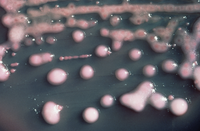
Photo from wikipedia
The increased prevalence of carbapenemase-producing Enterobacteriaceae (CPE) has made essential the design of quicker tests for CPE detection. In the present study, a simple and rapid assay was developed based… Click to show full abstract
The increased prevalence of carbapenemase-producing Enterobacteriaceae (CPE) has made essential the design of quicker tests for CPE detection. In the present study, a simple and rapid assay was developed based on measurement of the hydrolytic activity of imipenem at a final concentration of 65 µg/mL (100 µM) through ultraviolet-visible (UV-Vis) spectrophotometry. All measurements were conducted at 297 nm. A total of 83 carbapenem-non-susceptible CPE, consisting of Klebsiella pneumoniae clinical isolates and genotypically characterised as KPC-, VIM-, NDM- or OXA-48-producers, were tested. For comparison, 30 carbapenem-non-susceptible clinical isolates, consisting of Escherichia coli and K. pneumoniae and genotypically confirmed as non-CPE, were also examined. The spectrophotometric assay enabled efficient discrimination of CPE from non-CPE isolates even in 45 min (P < 0.0001). Moreover, the presence of phenylboronic acid (PBA) or ethylene diamine tetra-acetic acid (EDTA) in the reaction mixture was able to inhibit the hydrolytic capacity of KPC- or metallo-β-lactamase (MBL)-producers, respectively, while the hydrolytic activity of OXA-48-producing strains was not affected by the presence of these inhibitors (P < 0.001). The newly developed assay presented 100% sensitivity and specificity to detect and differentiate KPC-, MBL- and OXA-48-producers compared with genotypic characterisation. Thus, the proposed spectrophotometric method can be considered as an easy, fast, accurate and cost-effective diagnostic tool for screening carbapenem-non-susceptible K. pneumoniae isolates in the clinical laboratory.
Journal Title: International journal of antimicrobial agents
Year Published: 2020
Link to full text (if available)
Share on Social Media: Sign Up to like & get
recommendations!